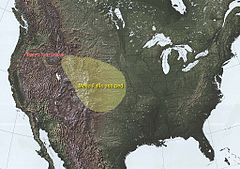Mesa Falls Tuff
Appearance
| Mesa Falls eruption | |
|---|---|
 Mesa Falls Tuff exposed at southern rim of both the Island Park Caldera and the Henry's Fork Caldera near Ashton, Idaho. | |
| Volcano | Henry's Fork Caldera |
| Date | 1.3 million years ago |
| Type | Ultra-Plinian |
| Location | Idaho, United States 44°20′N 111°20′W / 44.33°N 111.33°W |
| Volume | 280 km3 (67 cu mi) |
| VEI | 7 |
 Extent of the Mesa Falls ash bed | |
The Mesa Falls Tuff is a tuff formation produced by the Mesa Falls eruption that formed the Henry's Fork Caldera that is located in Idaho west of Yellowstone National Park.[1] It is the second most recent caldera forming eruption from the Yellowstone hotspot and ejected of 280 km3 (67 cu mi) of material. This eruption, 1.3 million years BP, was preceded by the Huckleberry Ridge Tuff and succeeded by the Lava Creek Tuff, both of which were also formed by the Yellowstone hotspot.[2]
See also
[edit]References
[edit]- ^ Christiansen, R.L., 2001, The Quaternary and Pliocene Yellowstone Plateau Volcanic Field of Wyoming, Idaho, and Montana: U.S. Geological Survey Professional Paper 729-G, 145 p.
- ^ Yellowstone Caldera, Wyoming
Categories:
- Yellowstone hotspot
- Volcanism of Idaho
- Volcanism of Wyoming
- Geologic formations of Wyoming
- Geologic formations of Idaho
- Landforms of Yellowstone National Park
- Quaternary Idaho
- Quaternary Wyoming
- Tuff formations
- VEI-7 eruptions
- Volcanic eruptions in the United States
- Plinian eruptions
- Pleistocene volcanism
- Volcanology stubs
- Western United States geologic formation stubs
- Wyoming geography stubs
